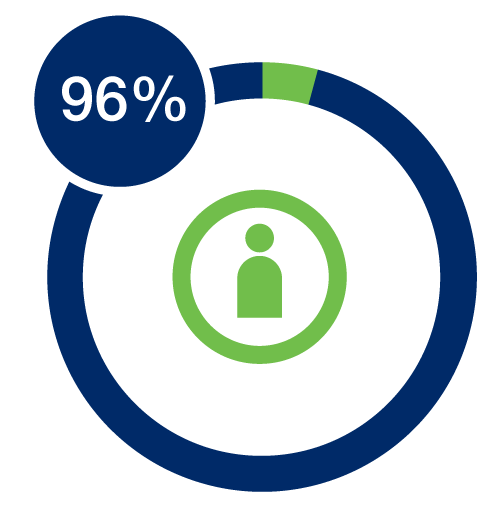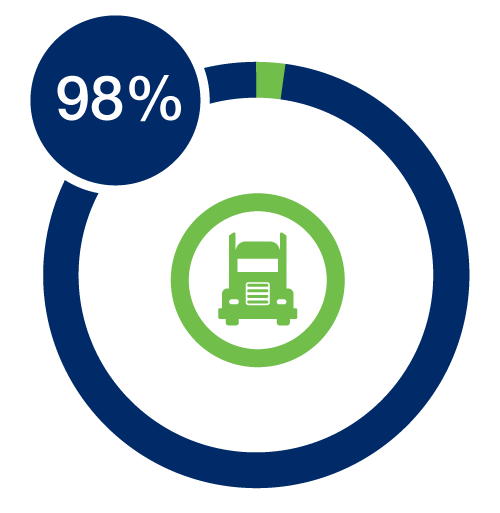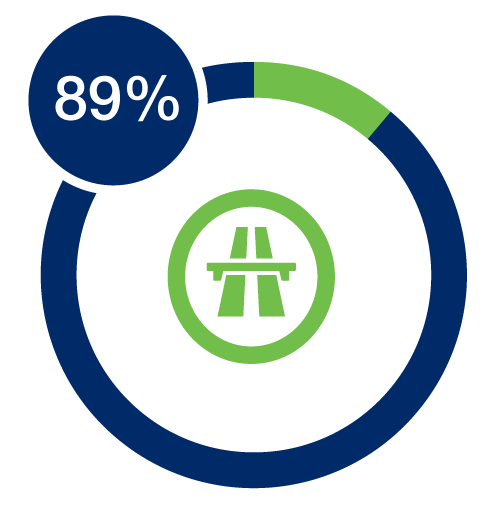
Results based service delivery.
Optimise real-time traffic management of the network, provide traveller information, improve asset management planning and support service delivery.
The program includes activities associated with the:



Our Traffic Operations Centre (TOC) monitors and manages the Perth metropolitan road network and is the central contact point for real time traffic information across the State. We refurbished the TOC control room to cater for a 70% increase in workstations. Training has commenced for TOC employees on the new STREAMS integrated incident and traffic management system.
Other improvements through the year included:
As part of our Congestion Management Plan, we implemented a towing service to help clear blockages from illegal clearway, no stopping areas and bus lanes in the Perth CBD. The initiative was launched on 22 August 2014, and following a two week education and awareness program that came into operation on 9 September 2014.
Since then, more than 4,500 vehicles blocking clearways, no-stopping zones and bus lanes have been removed by contract towing services. The initiative has made more traffic lanes available in the CBD during peak periods, improving traffic flow and helping make the roads safer.
We updated and released the Traffic Management for Works on Roads Code of Practice in March 2015. The revision streamlines applications for obtaining Worksite Traffic Management Accreditation. The revision was supported by presentations to interested parties and bodies with Instruments of Authorisation and staff who authorise traffic management plans.
A trial was undertaken as part of our Pedestrian Countdown at Traffic Signals project to remove the flashing red man being shown in the clearance phase at traffic signals, and replace it with countdown numbers to inform users how long they have left to finish their crossing. Five sites were chosen within the Perth CBD at the ends of both Hay Street and Murray Street malls and at the crossing outside Perth Railway Station across Wellington Street. We received a 95% approval from the public through our website for the changes. No crashes were recorded and there was no incease in vehicle and pedestrian conflict during the trial.
Vehicles over 19 m long, 4.3 m high, 2.5 m wide or over 42.5 tonnes gross mass are classed as Restricted Access Vehicles (RAVs). Heavy Vehicle Services regulates RAV access to the State’s road network via a system of notices and permits, and is developing and implementing measures to improve efficiency, road safety, community amenity and the preservation of road infrastructure. The following are some of the initiatives we have progressed over the past 12 months.
Chain of Responsibility legislation was introduced in April 2015 and is a milestone moment for road safety in Western Australia. The legislation aims to promote compliance and road safety, as well as minimise the impact on the road network.
Our ongoing State-wide communications campaign continues to inform industry and other stakeholders of the changes and potential impacts on their businesses. Outcomes include improved road safety, minimised unfair competitive advantage among operators, and better protection for infrastructure and the environment.
We monitor and improve heavy vehicle compliance outcomes of road safety and infrastructure protection, minimising the impact of road transport on the community, and reducing unfair competitive advantage through non-compliance. This year, our Transport Inspectors provided support to Police for Austrans, a national heavy vehicle enforcement campaign that took place throughout the State during May and June. The multi-jurisdictional approach by enforcement agencies brought together Main Roads, WorkSafe, Comcare, Department of Mines and Petroleum, Department of Transport and the Department of Fisheries. It targeted heavy vehicles for road breaches including fatigue, mass, dimension, load restraint, permit breaches, speeding, unroadworthy vehicles, as well as unlicensed drivers and vehicles and drug or drink driving offences.
Regulatory arrangements for the accreditation of pilot vehicle drivers is currently split across three Government agencies and training providers. This fragmented approach is confusing for pilots and the broader transport industry and makes it difficult to manage standards. We are working towards becoming the sole agency responsible for a new pilot accreditation scheme that will include a regulatory framework to incorporate all relevant legislation, regulations and administrative requirements for pilots in Western Australia. This approach will improve the professional standards for pilots, provide consistency and ensure the ongoing safety and sustainability of the road network.
We developed industry information sessions to meet the shortfall in industry knowledge relating to the administrative and regulatory requirements of operating a RAV within Western Australia. We held the first session in November 2014 and information sessions are now run quarterly. The presentations cover trending topics or issues identified by front line teams and customers, as well as the option for an individual consultation which allows transport operators to discuss specific issues with our subject matter experts. With the continued success of the information sessions, we will be developing and rolling out regional information sessions. For more information visit our website.
We are developing an extra mass management scheme to replace the existing 20-year old framework. Accredited Mass Management Scheme seeks to reward operators by permitting them increased axle mass limits, where superior loading controls and management systems can be demonstrated, while continuing to maintain high standards of road safety and infrastructure protection. It also gives transport operators greater flexibility by allowing any type of loading control and any type of product load, whereas the previous scheme required certified weight bridges and was restricted to bulk products. Following approval by the Ministerial Heavy Vehicle Advisory Panel, we rolled out the first stage of the new scheme, which amalgamated several existing schemes with the added benefit of introducing new higher mass limit in line with the national scheme.
In 2014, we won both the Technical Excellence Award and Most Outstanding Project Award for the integration of mobile, terrestrial, airborne lidar and imagery technologies for rapid feature mapping of freeway corridors at the WA Spatial Sciences Excellence Awards. In addition during August 2014, one of our Senior Road Planning Officers, Hannah Ruprecht, was awarded the 2013 VicRoads Prize in Transport Engineering Award.
Our Bridge Management System is used to undertake asset management activities through a series of modules which have been enhanced throughout the year, including the deployment of new software on portable tablet devices for staff undertaking annual visual bridge inspections. This means that maintenance work identified in inspection reports can now be automatically uploaded and recorded for inclusion in the maintenance program. Tracking of the number of inspections completed is also now much easier, accurate and transparent. An added efficiency benefit is that the processing time for reports is now five times faster than the previous paper based process. We also implemented improvements to the management and tracking of heavy vehicle load rating information. This allows quick generation of various advice for critical repairs, load posting and construction complete notifications. Enhancements also now enable staff to identify outstanding load ratings and better track progress. These enhances have resulted in significant improvements to processes, availability of bridge data and programming functions as well as substantial efficiency gains.
We developed an innovative web application to provide accurate and high resolution imagery sourced from Landgate to our staff. This new application also allows users to:
We have started to develop route strategies for the Rural Road Network across the State. Route strategies represent long term (40 year) needs and risk-based development programs. They are designed to:
We have completed a Route Investment Strategy for Albany Highway and work has commenced on strategies for the Great Northern Highway and Great Eastern Highway in the coming year as we roll out a program to prepare similar strategies for the entire State.
Sensors were installed on a Rockingham Road bridge to provide more information on its performance under vehicular loads. The network of 52 sensors includes strain gauges, displacement transducers, accelerometers, a camera and a weather station. The bridge is part of a designated heavy haulage route that crosses a busy section of the Kwinana marshalling yard. Continuous data has been received on the structure’s response to loading since August 2014. The monitoring system has the capability to alert and record events when the structural response exceeds preset thresholds. The bridge will be monitored initially for five years. The project is the first of its kind in Western Australia and illustrates the application of modern technologies for bridge management.

The travel map delivers up-to-date, accurate and consistent information in a visual format so that road users can plan their journey anywhere in Western Australia. It gives customers a comprehensive overview of road works, incidents and events happening across the Western Australian road network.
The travel map went live in February 2015 in preparation for the largest public Perth Festival event – The Giants. This “once in a lifetime” spectacle brought around 1.4 million people into Perth over three days. We knew from early event planning that accurate traffic information would be critical in enabling commuters and event goers to navigate the complex maze of road closures.
Customer feedback on the new map sought through our website and Customer Information Centre will inform requirements for Phase 2. Additional functionality will include better mobile usability, map loading based on location, improvements to the search function, and an option to close a section of road or geographical location where multiple road closures or long lengths of roads are closed or affected by works. To see the map visit our website.
Our aim is to provide a holistic view of road conditions, events and traffic across Western Australia.
The travel map went live in February 2015 in readiness for the largest Perth Festival public event – The Giants
CONNECT WITH US